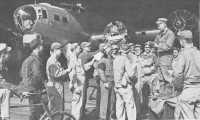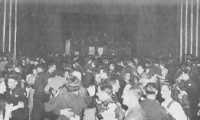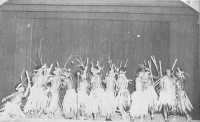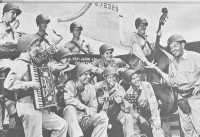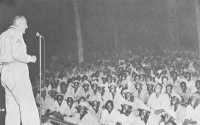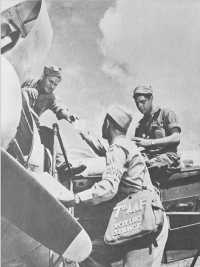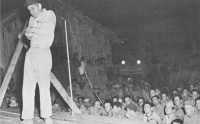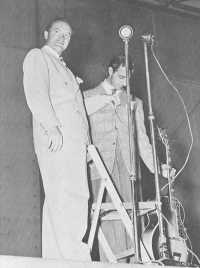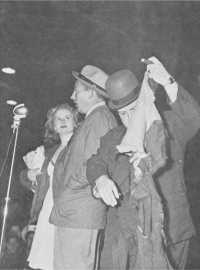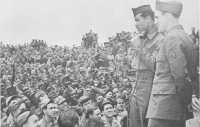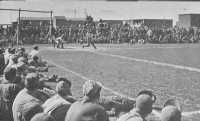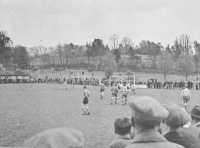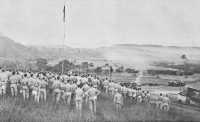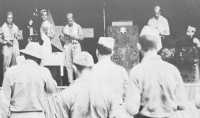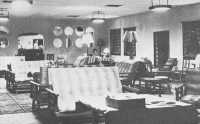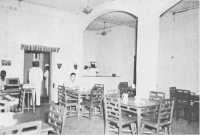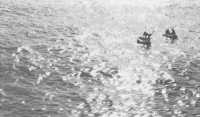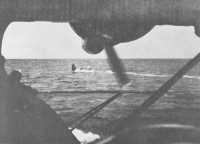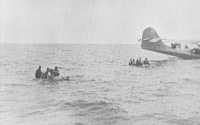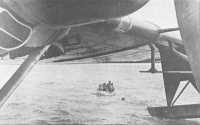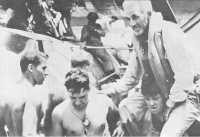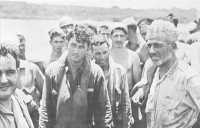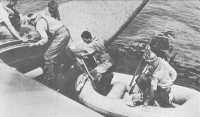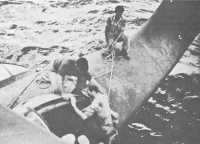Chapter 14: Morale
For more than forty; centuries military specialists have explored the subject of morale in an attempt to isolate and master those elusive forces that fire or wet down the spirits of men at arms. The incomplete success of these efforts is indicated by the fact that there is still no commonly accepted definition of morale, nor is there a definitive list of factors which affect morale; and any discussion of the relative importance of various factors is almost bound to lead to disagreement. There are few soldiers, active or discharged, who never have volunteered quick dicta on morale in particular and the Army life in general. But although such opinions, grounded as they may be in steamy memories of Papua or gritty afterthoughts about Cyrenaica, often glow with the heat of felt experience, they do not fill the need for some working definition which will at least serve present purposes. In this chapter,1 “morale,” that “most abused, most misunderstood”2 term, will be taken to denote an attitude of mind which, when favorable, leads to the willing performance of duty under all conditions, good or bad, and which, when unfavorable, leads to the unwilling or poor performance, even perhaps to nonperformance, of duty under the same good or bad conditions.
Neither this nor any other definition can eliminate, however, the difficulties posed by considerations of time and place for anyone who undertakes to assess the morale of the Army Air Forces in World War II. Any statement about morale in the Caribbean during the intense activity of the 1942 submarine crisis, for example, would not apply to the final period of the war when the area had sunk back into relative obscurity and the Sixth Air Force seemed as remote from violent conflict as the Spanish galleon on its shoulder patch. The problem of place is illustrated by the radical contrast between the
Eighth Air Force in Britain and the Thirteenth Air Force in the South Pacific. The two air forces lived different lives in different geographical areas with different levels of civilization; they fought different wars under different climatic and combat conditions; and they enjoyed, or suffered with, different priorities and differing degrees of independence, prestige, strength, and fame. These and other distinctions arising in some measure from the accident of place exerted a variable influence on the morale of each organization.
Another obstacle to a precise estimate of morale is the problem of measurement. Traditionally, it has been assumed that the incidence of venereal disease provides a reliable index of troop morale. But actually VD statistics, however full, cannot be evaluated apart from such questions as the availability of women,3 variations in the incidence of venereal disease among procurable females, the frequency of intercourse, the effectiveness and convenience of prophylactic aids, and the level of soldierly enthusiasm for the healing powers of penicillin. In short, the incidence of VD was conditioned by many factors.
Perhaps the most formidable obstacle to gauging morale correctly in the Army Air Forces is the evaluation of subjective evidence. There are only a few leading documents on morale, and these have limited usefulness. With distinguished exceptions, unit historians – whose work is perhaps the chief quantitative source of information on the subject – did their job perfunctorily as an unwelcome added chore for which they had had no preparation. Some overlooked morale completely, some gave it only a dull glance, and others handled it with a delicacy appropriate to NCO’s and junior officers who wrote with one eye on the commanding officer through whose hands the record of the organization’s achievements must pass before it ascends to a higher headquarters.4 There is reason to ponder, for instance, the balance and accuracy as well as the rhetoric of reports which declare that “morale has pierced its highest ebb”; reason to wonder if the acid content of other histories can perhaps be traced to an affliction of the author’s spleen; and, in any case, good cause for handling most of the evidence on morale with unusual care.5
The inevitable question remains. Is it possible to move past the obscurities of the record to a generalization about morale? The answer is a cautious, rather reluctant “Yes.” The available testimony, which of course can never add up to an arithmetically clean sum, appears to justify the following statement: Morale in the Army Air
Forces during the second World War hovered, on a rough average, between fair and good. It varied in some degree from man to man, unit to unit, air force to air force; it could soar above “good” to rarefied heights or tumble below “fair” into a black slough; and in all places at all times it reacted with the sensitivity of a compass needle to every change, every shift in conditions. But, extremes and fluctuations aside, morale more often than not seems to have clung to a middle or perhaps slightly higher level. When positive and negative influences tended toward equilibrium, certain basic constants made for a favorable balance. Most airmen never really doubted that they were on the winning side in a great war,6 and no amount of standard grousing could obliterate the obvious fact that concern for their well-being had generated a remarkable welfare effort – civil and military, public and private – whose effects could be felt from the hill stations of India to the most implausible PW locations inside Germany7 And, if all else failed them, airmen could always take comfort in the thought that they might have been in the infantry.8
But any generalization about AAF morale, in applying to all men and all units, applies to no man and no unit. The following discussion attempts to add substance to the spare frame of generalization and also to furnish the corrective qualifications full-blown statement about the ways of human beings must have. If the discussion at times takes on a dark hue, that coloration undoubtedly reflects in part the concern of most of the documentary material with the problem side of morale and the tendency of men in uniform to speak more of woe than of weal.
In Training
From the earliest days of the war period the AAF grappled energetically, if not always successfully, with the inevitable morale problems produced by the service’s explosive expansion. Regulations, field manuals, directives, memoranda, and other forms of injunction, advice, and exhortation ,provided subordinate commanders, chaplains, and junior officers with prescriptions for safeguarding the morale of the hundreds of thousands of recruits then flooding into AAF basic-training and classification centers.9 Among other things, the military leader was to know his men, take an interest in their concerns, earn their respect and their loyalty, eschew cursing them, promote their comfort and welfare, be patient, considerate, calm, firm, and vigorous,
keep the men informed, show enthusiasm, never assign pointless tasks, explain the reasons behind orders, preserve good health, make sure that uniforms fitted, help solve family financial problems, check on laundry facilities, and bid a furloughed soldier a cheery farewell.10 In such fashion the AAF provided ready-made paper solutions to all matters even tenuously related to morale. Reality, however, shied away from ideality, and nowhere was this more true than in AAF basic-training centers.
The obstacles to high recruit morale at AAF basic-training centers were varied. Many of the men arrived from reception centers in a condition of bruised bafflement after sustaining the first shock of military life. If they expected to find a refuge at such typical stations as Basic Training Center No. 7 at Atlantic City or Basic Training Center No. 9 at Miami Beach, where in 1942 and 1943 surging growth and kaleidoscopic change were normal, they were disappointed. Unit commanders or their representatives greeted trainees with inspirational orientation talks whose quality varied according to the interest and talent of the speaker.11 Whatever good such sermons may have achieved in replacing bewilderment with an understanding of the aims and methods of basic training, and in creating unit spirit and confidence in the training commander, was often dissipated by experiences that followed. In practice, two-way communication between the separate worlds of recruits and training-group officers was rare. Budding loyalties withered when officers whirled, revolving-door fashion, into and out of training unit commands every two to three weeks or – in one extreme case – six times in a month and when the need to furnish cadres for new organizations set off a series of raids on the permanent party ranks of existing basic-training groups. Jefferson Barracks alone, for example, turned out forty Technical School Squadrons cadres in 1942.12 Furthermore, instructor officers were in short supply, many had marginal qualifications, regarded their assignment as a punishment for past sins and a bar to future grace, and, whatever their personal feelings may have been, were too sorely beset by multiple duties to pay direct attention to trainees. Permanent party enlisted personnel – especially drill instructors, who as a group were closest to the recruits and played key roles in the basic-training program – also failed to measure up to standards in quantity and quality. Many of them had been picked helter-skelter, were understandably bemused by the starts, stops, and switches of training programs,
suffered themselves from contagiously low morale, or were simply incompetent. As time passed and pressures eased, it became possible to improve the permanent party situation, but this upturn came too late to help thousands of trainees who in 1942 and 1943 absorbed from their supervisors little sense of mission or common purpose. There were, of course, exceptions – unit commanders and instructors who tackled their jobs with intelligence and enthusiasm and who were rewarded by fine results.13
Job classification and assignment had perhaps a greater influence on trainee morale than any other step in the process of basic training. If necessary, most recruits would probably have been willing to shrug off basic-training-center shortcomings as a price to be paid for the long-run benefits promised by proper classification and assignment. The woes of the drill field were fleeting; but the decisions of classification and assignment sections might, as far as wartime military careers were concerned, endure forever. Contemporary soundings of soldier opinion show that the AAF outstripped the Army Ground Forces and Army Service Forces in giving men the jobs they wanted and for which they felt best qualified. There was, nevertheless, widespread discontent on this score.14
In the case of aviation-cadet applicants who had volunteered for induction with the expectation of receiving immediate college training but were instead subjected to psychological and medical tests that barred them from the aircrew program, the trouble was rooted in the excessive zeal of AAF recruiters and, fundamentally, in the sharp competition between the services for manpower.15 Another serious problem developed when quick shifts in AAF needs jarred and sometimes stalled the carefully crafted machinery of classification and assignment. Theoretically, civilian background, AGCT scores, results of aptitude tests, and personal choice determined the classification of a recruit. But time and again the pressure to fill school quotas by any available means wiped out the good work of classification sections; thus, to the cheerless tune of “exigencies of war,” qualified weather-observer candidates set out for radio school, and qualified draftsman candidates in turn went off to auto-mechanics school. Although such instances of misclassification and malassignment were in a minority, they cropped up too often for comfort and dealt a hard blow to the morale of the victims. Admittedly, the erratic appetite of war forced the AAF to reshuffle requirements frequently. Yet
there was a strong feeling that better planning could have prevented much grief. Once the damage was done, repairs were difficult. As late as March 1945 the Eighth Air Force, for example, was still struggling to right the wrongs of malassignment.16
The clear, direct influence of leadership, training procedures, classification, and assignment on the morale of basic trainees is unquestionable. But the effect of other factors defies easy measurement. Floorless, stoveless tents pitched on marshy ground at Keesler Field, throttling dust at Sheppard Field, rain and muck at Greensboro AAB, and extremes of heat and cold at Jefferson Barracks certainly offered little cause for jubilation. But, though such conditions could aggravate an already bad morale situation, it seems doubtful that they alone would ordinarily create one. Nothing in the record, furthermore, proves that recruits in an uncongenial setting had a markedly lower morale than those who were in the Babylonian environs of Miami Beach.17 Army Emergency Relief, the American Red Cross, the United Service Organizations, base legal officers and chaplains-all in their several ways gave aid and comfort to trainees and thereby made a definite, if limited, contribution to morale. Similarly, post facilities for relaxation – theaters, service clubs, post exchanges, day rooms, gymnasiums, and libraries – played a useful role by offering diversion and amusement during leisure hours. Their importance, however, could be and was exaggerated. Secretary of War Stimson, never one to deny the worth of off-duty pleasures, bridled at the idea that “the morale of any army could be measured by the number of its recreation halls and canteens.”18 This view, which Stimson spurned as a delusion, was held far more widely than he liked. There was a tendency to try to dispose. of morale by tucking it into a separate compartment of army life, where it could safely be left to the ministrations of “morale agencies.” According to Stimson, morale depended finally on the training that a soldier received and on his confidence in his military leaders; but in the eyes of the AAF Training Command, among others, it seemed to hinge rather on the energy of the Special Services officer. Thus at Miami Beach, as one chaplain complained, morale was looked upon as the peculiar province of Special Services, whose efforts boiled down to little more than a series of extravaganzas at the Pine Tree Bandshell.19
Recreational facilities were especially incapable of undoing the damage done to morale by dislocations such as often occurred at the
end of basic training. By that time most recruits, for better or worse, had exhausted the possibilities of basic-training centers. If, for example, they had fared well in classification, they could expect to gain little by marking time on drill fields or in front of mess-hall sinks; and if they had fared badly, a prolonged stay at the scene of disaster promised equally little. For these reasons and perhaps because of native restlessness, there was a general urge to move on to the next step in AAF training as fast as possible. When trainees had high hopes of shipment to schools without protracted delay, their morale reflected that optimism. But, when uncoordinated training periods and shifting quotas slowed down or damned up the flow to schools, morale sank. The longer men stagnated in pools, the more dispirited they became. Pass and other restrictions which had hobbled them as raw recruits continued to harass them in their new role as casuals; and, though advanced training programs were concocted to keep them profitably occupied, they still spent much of their time – when they were not on KP, guard, and fatigue details – literally as well as figuratively going over ground that was familiar. One battle-eager youngster who went on a drunk after six months of frustration at Atlantic City swore that he knew every brick in the road to the drill field and insisted that he had pushed a broom far enough to cross the adjoining ocean.20
Pools of idle manpower were not peculiar to basic-training centers. At one time or another they collected at almost every level of the Zone of Interior training program and, on occasion, both before and after a particular phase of schooling.21 And, wherever or whenever pools appeared, the predictable consequences were administrative aches and morale pains. The aviation-cadet program, to cite a notable case, was cursed with a pool problem, or a complex of pool problems, of oceanic dimensions from the outbreak of war until V-J Day. An ill-fated combination of all-out recruitment, inadequate facilities for handling the men recruited, and precipitate ups and downs in aircrew requirements led to the accumulation of masses of cadet applicants and cadets waiting, variously, to go on active duty, to enter the college-training program, to get out of college training and into preflight schools, and to escape from postpreflight holding points into the flying schools, where, as many cadets later learned, more pools had formed. Each of these pools became, as might have been expected, a slough of despond. Morale may hit its lowest mark, strangely enough,
in the ranks of men who had not even donned uniforms – Air Corps Enlisted Reservists whom the AAF could more readily recruit than absorb.22 The AAF, pricked by barbs of criticism, argued in self-defense that the fast-changing nature of the war made pools inevitable. Undoubtedly, the argument had force. But there were indications that the pool problem might have been eased and morale stiffened through closer co-operation between Headquarters AAF and the Training Command as well as through a quicker realization by planners that what they regarded as a passing migrane was actually a permanent question which called for a better answer than makeshifts or convulsions of policy.23
That morale in the flying and technical training schools of the AAF often fell short of the desired standard should have surprised no one. A military academic machine which previously had existed only in miniature, and which now in three and one-half years produced 670,014 aircraft-maintenance specialists, 128,877 armament specialists, 299,104 radio specialists, 297,318 aerial gunners, 74,400 single-engine pilots, and equally impressive numbers of other specialists,24 was almost inevitably destined to be troubled by problems arising from hasty construction and human frailty.
In October 1943 an emissary from Headquarters AAF made a five-day inspection of the cadet armament course at Yale and wrote a glowing report on the excellence of the school, the “really first rate’’25 quality of the teaching, and the enthusiasm of the students. But elsewhere, at schools unblessed by ivied comforts, conditions were less idyllic. Tent cities of the kind that once graced Kelly Field, temporary structures which proved pathetically inadequate in winter at Sioux Falls, South Dakota, and in summer at southern bases where 120º F. temperatures were frequent, and general overcrowding at many fields did not nourish high morale.26 Nevertheless, though the radio students who trudged through the dead cold of a Wisconsin winter night to 0200 classes at Truax Field might not have appreciated the fact, the basic morale problems of AAF schools – like those of recruit-training centers – probably did not spring from physical sources.
Nowhere was this more apparent than among those whose task it was to teach the students – the instructor personnel. Their pains were largely of the spirit and the pocketbook. Complaints of injured morale arose during the protracted delay and confusion that accompanied
the commissioning of civilian instructors at preflight schools in 1942, and similar protests resulted, once again from the efforts of overzealous AAF recruiters, who, hard pressed to outbid the Navy and secondary rivals in another phase of the scramble for manpower, had oversold civilians on the rank, promotions, and assignments they might expect upon entry into service. The question of promotions appears to have been the chief focus of discontent among the instructors. Far from real war and its stimuli, sometimes malassigned and keenly aware of their unfitness for their task, and demoralized on occasion by lackluster leadership (always a major morale factor, but one rarely discussed except in generalities) or by the sheer boredom generated by a standardized teaching system which allowed little room for individual initiative,27 many instructors often tended to lay especially heavy stress on personal rather than organizational goals. Motives aside, there was objectively good cause at times for agitation over the promotion situation. The argument that there never would or could be enough promotions to make every man’s cup run over did not comfort those officer instructors whose chances for advancement started to fade early in 1943. One legitimate reason for shutting the doors was that too many men had become eligible for promotion at the same time. But this fact was outweighed in the minds of many instructors by the knowledge that officers in administrative and other favored categories were getting most of the available promotions. Morale and efficiency fell off when hard-working instructors had to plod along as second lieutenants for a year and a half to two years while their more happily situated peers moved ahead of them in rank.28
Enlisted instructors, for their part, felt no urge to shed tears over the fate of junior officers who, after all, enjoyed the perquisites and immunities that went with a commission. Their own predicament was worse, and their morale that much more affected. Civilian instructors, for example, not only earned higher pay than enlisted men for equal work, but were free from many of the restrictions that hemmed in military personnel. At the Laredo Central School for Flexible Gunnery officer students were taught by privates who received a full measure of KP and like assignments but no promotions, To the low-rated men on the faculties of other flexible-gunnery schools, the dearth of promotions was injury enough; every graduation day, however, seeming insult was added when a new batch of freshly striped sergeant or staff sergeant gunners rolled off the academic assembly
line.29 Those gunners who went on to armament school at Buckley and Lowry Fields had a catalytic effect on the faculties there, too. many of them outranked their instructors and believed, furthermore, that after gunnery training they had nothing more to learn about armament, The result was a compound of disciplinary trouble and lowered instructor morale. Some relief came with the adoption of a policy providing that in the future all armorer-gunners would receive armament training before going on to gunnery school and noncommissioned officer status. A more positive balm was the opportunity for instructors to qualify for the cadet armament course, which led to an armament officer’s commission. The Training Command also made a number of attempts to raise morale and the quality of teaching by side-stepping Table of Organization restrictions and other obstacles to higher rank for instructors, but these efforts met with incomplete success. Administrative heads continued to be worried by the problem as late as November 1944.30
A majority of the students who swarmed into the AAF’s school system approached military education with attitudes ranging from willingness to outright enthusiasm.31 The average airman was inclined at the least to welcome schooling as a forward step along the road to a military career which, if it did not lead to glory, might nevertheless have its satisfactions and postwar uses. Technical training and flying training also offered the immediate attractions of novelty, inherent interest, and, for some, excitement. There were, of course, shortcomings in working conditions, living conditions, and other areas of school life, but such departures from perfection were half-expected and wryly accepted by men who had already sloughed off their illusions during the shakeout process of basic training or cadet classification. More positively, administrative efforts to ease or end irritants had a therapeutic effect on morale. Student protests, for example, over the damage that had resulted from the piling of purely military training on top of a full program of technical training led by early 1943 to a sharp cutback in military activity at schools. To cite another case, the gradual elimination of night shifts – long an object of mass reprobation – gave students more sleep and time to recharge their energies and served as a tonic to their spirits.32 And the use of such incentives as promotions, competition, and enhanced opportunity based on merit similarly helped to revive flagging morale. So it was that most men went through the school phase of military life, sometimes cast down
by adversity or the repellent drabness of their work,33 perhaps more often buoyed by a different set of influences. ‘This majority group, like any group, undoubtedly had its morale problems, but they were not usually of the virulent kind.34 The real trouble lay elsewhere.
The glider-pilot program produced the most spectacular case of mass low morale in the record of the Training Command. Haste, ignorance of the nature and conduct of both glider training and operations, uncertainty of purpose, and lack of clear responsibility were at the root of the troubles that developed when, in 1942, the AAF rushed headlong into this new activity. Because the shortage of manpower had made it difficult to round up enough glider-pilot candidates during a period in which the program’s goals shot up more than seven fold, extravagant advertising – with its stress on money, rank, and thrills – and lowered physical standards became the order of the day. The resulting enlistments overwhelmed the glider schools. Large pools of waiting men gathered. Then, as the entire program was drastically cut back in the spring of 1943, when about three-fourths! of the hapless trainees were reassigned, morale dropped even lower to become “an extremely serious and almost insurmountable … problem,”35 Of the survivors, many were dropped on physical grounds just before graduation. It was not until that late hour that they underwent physical examinations.36
The misfortunes that plagued the glider program were confined, fortunately, to a small segment of the AAF school network. No such isolation occurred, or was possible, in the case of men who had been eliminated from the various aviation-cadet programs. A high percentage of these washouts not only suffered from their own personal disappointment but constituted a menace of epidemic proportions to the morale of those with whom they came in contact. At Scott Field disgruntled eliminees who had been shunted into radio school showed no desire to mend their fortunes and behaved dourly enough to provoke a senior officer into denouncing them as sources of contagious rot.37 Similarly, the great majority of flying-school eliminees in the cadet armament course at Lowry Field early in 1942 appear to have earned for themselves nothing more distinguished than the epithet “defeatist.”38 Administrators were also hard pressed to cope with the cadets who came to navigation or bombardment schools after being washed out of pilot training. Here the curriculum deserved a good measure of the blame for the eliminees’ bleak mood, for until 1943
these reluctant navigators or bombardiers were forced to grind through the same preflight course they had already completed during their pilot-training days. Morale rose when an overhaul of the flying-school system finally put an end to this pointless repetition. There were those who felt, however, that the whole eliminee problem might never have arisen if attempts had been made to quarantine washouts and minister to their morale before they went on to new assignments. Whether or not the Training Command had the time and personnel for a campaign of mass rehabilitation is questionable. But the success of at least one experiment in careful reorientation in 1944 suggests that such an investment of effort might have yielded liberal dividends.39
The great majority of combat veterans who flowed into the training mill fresh from overseas duty were afflicted, like cadet washouts, with infectiously poor morale. Again, as had been the case with the washouts, responsibility for this condition was mixed. For their part, the authorities charged with the classification and training of returnees generally tackled the job with the best intentions. Unfortunately, a gap of remarkable breadth separated theory from common practice. Thus, when demand waxed for the use of combat veterans as instructors, returnees suddenly found themselves tagged as pedagogues – whether or not they yearned for the role or had the talent to play it. Those who voluntarily went to an instructors school got along well, but those who looked upon their new career as a grievous form of involuntary servitude soon showed characteristic signs of maladjustment and poor morale. They clashed with permanent party men, failed courses with disturbing frequency, and aroused serious concern over their attitude.40
Virtually every technical or flying school carried on its rolls a number of men whose morale had allegedly been damaged by faulty classification or malassignment. True enough, the machinery of classification and assignment did function more than once with the fine discrimination of a bulldozer, but its behavior hardly accounts for all the claimed injuries. In many instances students seemed to be suffering more from the frustration of personal plans and preferences than from actual mishandling. This was perhaps especially true after the crisis mood of the first eleven months of the war had faded41 without being replaced, in the case of rootless trainees, by some counterforce like organizational pride or the pull of leadership that might have
helped men through the process of subordinating individual desires to the demands of military necessity. Reports from technical schools spoke of the problem of dealing with recalcitrant students who either objected to the kind of training they received or wanted no training at all. Their low spirits probably sank further under the added weight of a feeling of futility when it became known that, in spite of orders from Headquarters AAF, newly acquired specialist skills were frequently going to waste in operational units.42 Flying schools had troubles of their own. Some small-sized pilots, for example, raised an outcry over their assignment to fighters, while others of all dimensions were just as outraged by assignment to bombers. Harassed training authorities tried to hew to a policy of voluntary assignment, but there were times when an urgent need for manpower – especially in the heavy-bomber program – forced them to override personal choices. The resultant drop in morale had to be accepted as one of the costs of an emergency situation.43
As the many tributary streams of air and ground specialists flowed from their sources in the Training Command and merged to form units, new morale factors came into play, and familiar ones took on new force. Once in a regularly constituted organization, men who had hitherto drifted through individual training as individuals found themselves in a changed world. For the first time – in most cases – they actually belonged to a unit with a permanence, a meaning, and a clearly defined purpose that Training Command school squadrons (whose numerical designations quickly faded into a half-forgotten blur) had seemed to lack. There might be tumult and confusion during the early weeks of an infant organization’s life, but in good time a feeling of identification with the unit began to well up in men-and with that emotion came a lift in spirits. The speed with which esprit de corps developed varied with the rate of personnel turnover, the availability of equipment and facilities for a prompt start on training, and – above all else – the quality of leadership shown by senior officers.44
Though it would be hard to claim that physical conditions had no effect on morale at isolated bases like Blythe, in the California desert, where summer heat was terrific,45 other factors generally exerted a graver influence. The most dramatic of these was a fear of flying in certain aircraft, There was nothing new about the phenomenon. It had cropped up in World War I when the DH-4 won temporary notoriety as the “Flying Coffin.” Two decades later the Spitfire – finest
of Britain’s fighters – also encountered much whispering suspicion after the occurrence of several crashes marked by wing collapse. In their turn, at least a half-dozen American aircraft of World War II became objects of worry and controversy. The P-38 came in for its share of criticism early in 1942 when a series of accidents involving this novel fighter set off a wave of applications for transfer to bomber units. The excitement died down and the wave of applications ebbed as pilots gradually mastered the airplane’s quirks. At about the same time the B-26 became the center of a greater furor whose echoes reverberated in General Arnold’s office. Almost from the day of its first delivery to AAF organizations, this medium bomber proved difficult to maintain and – much worse – dangerous for raw pilots to fly. As disaster followed disaster, a mood of panic spread from one B-26 base to the next and helped to add to the accident rate. The situation became so serious that, when an opportunity for transfer arose, every eligible pilot in the 320th Bombardment Group (M), with the exception of the commanding officer and his executive, either formally or informally stated a desire to escape from B-26 training to a safer kind of flying. It took changes in design, combined with lectures and aerial demonstrations, to convince crewmen that the B-26 would behave as well as any other airplane if handled properly.46 The Second Air Force, which concentrated on four-engined bomber-crew training, had its share of grief – first with the B-24 and later with the B-29. Trouble with these aircraft-as with others that came before them or after them-stemmed from inadequate maintenance work, combat-crew deficiencies, faulty supervision of the training program, and the maddening bugs that mar the early record of almost every untried airplane. During 1942 and 1943 the B-24 had the sorry distinction of being the Second Air Force’s “problem plane.” In 1943 alone, 850 Second Air Force combat crewmen went to their deaths in 298 B-24 accidents. The air of mystery that enshrouded many of these disasters had a doubly chilling effect on the morale of untouched crews. Four baffling crashes in rapid-fire order at Alamagordo, New Mexico, for example, led Gen. N. B. Forrest to report: “The people down there are scared to death of their airplanes and it is very bad.”47 Morale congealed almost as dangerously in the 34th Bombardment Group (H), which lost 7 B-24’s and 43 crewmen during a six-week stay at Salinas, California.48 The B-24 – like the P-38 and the B-26 – ultimately went
Mail Call, Bassingbourn, England
Dancing, G.I. style, Fighter Base, England
Dancing, Kanaka style, B-29 Base, Saipan
AAF entertainers on tour of Pacific bases
AAF entertainers at Thirteen Air Force Base
Voting service, Seventh Air Force
Celebrities: At Nam Lip, Burma
Celebrities: At Air Depot in England
Celebrities: At Bomber Base in England
Celebrities: At Air Base in Lancashire, England
Athletics, Eighth Air Force Base, England
Easter sunrise service, Thirteen Air Force
Jewish service, Thirteen Air Force
Enlisted men’s club in India, at ATC Base
Enlisted men’s club in India, at Air Depot, Panagarh
on to a notable record in combat, but not until many apprentice airmen had contributed heavily in lives and spirit to its trying-out.
Overcrowding at airfields, lack of convenient recreational facilities, and drastic shortages of housing for dependent49 were familiar but minor morale factors at this stage of the training program. Though these discomforts may have caused individual cases of discontent, most men in operational training units had by this time learned to shrug them off or accept them as the facts of Army life in wartime. But the issue of promotions was something rather new to the alumni of flying schools and technical schools who manned the organizations that were taking shape in the continental air forces. A majority of these men had spent most of their military lives in one form or another of individual training. As casuals they had moved about in a rigidly controlled economy where promotions either came automatically to all trainees in good standing at some point in the schooling process or were not open to any of them. Now, in the more flexible world of the numbered air forces, officers and enlisted men alike scanned bulletin boards and followed the latest Table of Organization developments with an interest that fed on high hopes of personal advancement. The general tendency to promote men to within one step of the maximum rank or grade allowed for their positions served as a spur to morale.50
The question of leaves and furloughs also began to loom larger on the horizon as airmen realized that their time in the Zone of Interior was running out. For most of them there had been little or no chance to break away from military routine-except on passes-until they reached the end of Training Command schooling. Between that point and their date of departure from the United States, they could normally expect-as a matter of policy-a leave or furlough of up to fifteen days, plus travel time. This last chance for a visit home might come before, during, or after OTU or RTU phase training-depending on schedules or unlooked-for lulls in activity brought on by a dearth of airplanes. In the case of unassigned men who had not received unit training, it might not come short of arrival at Overseas Replacement Depots. Early or late, these leaves and furloughs were a boon to morale.51 But, whenever they were unduly delayed, cut down, or written off, a decline in morale followed. Such was the experience of units of the XII Air Force Service Command which had abandoned preembarkation furloughs in the rush to meet TORCH commitments in 1942; and such was also the experience of the Training
Command and the Second Air Force after they had adopted similar emergency measures in the spring and summer of 1944 in order to fill their obligations to the OVERLORD forces in Europe and the B-29 project in the Pacific.52 At the Greensboro, North Carolina, ORD during this period, the moratorium on furloughs in combination with spit-and-polish discipline helped to send the court-martial rate soaring; while out in Kansas a senior general officer unwittingly made a difficult situation worse by declaring during an inspection of the 40th Bombardment Group (VH) that the group’s combat crews ought to have seven days of leave – a respite which they could not get and did not get because of the urgent need to modify their B-29’s and fly them away by a set date. The crisis soon passed, after provoking a near-mutiny at one base, and by November the Second Air Force could report that over 99 per cent of the men processed for transfer overseas by its 21st Wing had had leaves or furloughs at some time during the previous six months.53
Overseas
The approach of overseas movement usually acted as a signal for the appearance of an ailment that came to be known as “gangplankitis.” Its symptoms ran the gamut from nervous tremors to AWOL and desertion. It could crop up anywhere – at training fields, staging areas, overseas replacement depots, and ports of embarkation – and whether it would occur in mild or intense form was something no one could predict with certainty. Generally speaking, severe seizures were most likely to develop when organizational ties were weak or – as in the case of individual replacements who belonged to no unit – nonexistent; when leaves or furloughs and even passes were banned; and when men had long weeks of idleness in which to consult their fears of the unknown reaches beyond the piers of San Francisco or the runways of Morrison Field, Florida. But “gangplankitis” normally presented no grave problems. If the prospect of leave-taking aroused some qualms, it also generated a surge of excitement and high spirits powerful enough to overcome the drag of other factors.54
During the journey overseas the likelihood of morale difficulties tended to vary with the length of the trip: the longer the passage, the greater the problem. Those who traveled by air might praise or damn the assets and liabilities of such stopover points as Presque Isle, Borinquen Field, Goose Bay, Hickam Field, Natal, BLUIE WEST No. 1,
and Kwajalein. But these reactions were more or less fleeting. Movement by air usually offered the virtues of speed-except along the North Atlantic route in winter, which at least provided the compensation of Iceland’s Danish pastry-and variety. It mattered little if the food at a base in Trinidad were wretched; within twenty-four hours the complainants might be enjoying a meal in a hotel at Belém, Brazil. Similarly, if the sight of Ascension caused dismay, it did so only for a day.55 Men in ships were less fortunate. Few wartime voyages resembled the 27th Bombardment Group’s journey to the Philippines in November 1941 aboard the President Coolidge: the liner was comfortable and uncrowded, the diet – “steaks, squabs, cheeses of all kinds”56 – astonishing. After Pearl Harbor, those who traveled fastest along the shortest routes generally fared best. During a quick run from New York to the Firth of Clyde on the Queen Mary, cramped quarters, dismal food, and other shortcomings ranked only as passing irritations. But on many longer voyages-especially through equatorial seas-the heat, the overcrowding, the lack of ventilation, the surfeit of strange stews and other dubious dishes, the stench from overflowing commodes, the shortage of recreational facilities, and the nerve-grinding tedium of spending up to thirty-eight consecutive days aboard ship could blend into a corrosive mixture. Many of the discomforts and deficiencies were unavoidable, but, as anger boiled up over such affronts as gross inequities in food and food service, this fact was often forgotten.57
The chances of war brought American airmen into overseas settings that varied radically in nature and effect. Units could consider themselves thrice blessed if their movement orders took them to stations in a temperature zone where climate was tolerable, disease was no grave menace (save to the careless and incontinent), and living quarters were reminiscent of what they had known in stations in the United States. The worst that could be said of Eighth Air Force housing in Britain during 1942 and 1943 was that it did not equal the standards of permanent Zone of Interior installations. In southeastern Australia, facilities at Tocumwal and Melbourne struck Maj. Gen. George C. Kenney as perhaps even too comfortable to be militarily useful. And in China, during the summer of 1942, Kunming offered to the startled men of the 23rd Fighter Group a magnificent locale and accommodations that were as gratifying as they were unexpected.58
But East Anglia, New South Wales, and the valleys of Yunnan
were not the world. Elsewhere, from Shemya to Biak, from Youks-les-Bains to Espiritu Santo, airmen too often encountered conditions that subjected them to mass trials by fever and chill, dehydration and deluge, dust and slough, monsoon, khamsin, and williwaw. There was nothing temperate about the heat of Darwin and the north Australian bush country, the suffocating, clinging damp of the Papuan jungles, the bleakness and cold of the Alaskan mainland, the interminable grayness of the Aleutian chain, Bengal’s mixture of sun and stench, and the Libyan Desert’s winter blend of sandstorms and inundations. There was nothing reminiscent about the scrap-and-tincan dugouts that dotted the landscape at forward fields in Algeria, the washed-out tents at Magrun – “a hell hole if there ever was one”59 – in Cyrenaica, unwinterized Eleventh Air Force quarters at Elmendorf, the charnel-house atmosphere of Tarawa, Kwajalein, and other devastated atolls in the central Pacific, and the insect-ridden, snake-ridden, lizard-ridden, unfloored and unscreened pyramidal tents at bases in New Guinea. Nor was there any dearth of menace, or at least misery, in the onslaught of afflictions like malaria, dengue fever, scrub typhus, diarrhea and dysentery (“Karachi Crouch,” “Delhi Belly”) ,60 schistosomiasis, boils, abscesses, tropical ulcers, fungus infections (“Guinea Crud,” “Jungle Rot”) ,61 furunculosis, filiriasis, and “fevers of unknown origin.”62
During the early stages of combat operations, however, morale held up far better than might have been expected, in spite of physical conditions that ranged from poor to appalling. Disease, of course, could and did have a depressing effect. Malaria, for example, helped to drain reserves of strength and will in stricken organizations like the 11th Bombardment Group in the New Hebrides and Lower Solomons and the Fifth Fighter Command in Papua. Chronic dysentery had a similar if less extreme effect on personnel of the India-China Wing of the Air Transport Command. Perhaps equally depressing were the glaring contrasts that existed between the living standards of senior officers and their men in India in mid-1942 or between sailors and their poor relations of the Army on islands of the south and central Pacific at any date.63 But these cases fall far short of telling the whole story of morale in physical adversity. Given the spur of crisis, the compulsion of responsibility, the elemental pull of leadership, the feeling of pride in their unit, the excitement of participation in great undertakings, and the belief that all concerned were sharing and suffering alike, air
crewmen and ground crewmen in all theaters not only endured privation but did what they had to do with a drive and a spirit that many of them could never again summon up in later, physically easier, periods after the wear and tear of overseas life had taken its toll. Morale in some Twelfth Air Force units was never higher than during the winter months at Thelepte and other forward bases in North Africa when conditions were at their worst. On the other side of the world, verve, enthusiasm, and Sense of purpose carried many Eleventh Air Force men through the hectic days and hard times of 1942; but these had largely dissipated by 1944, to be replaced by the “demoralizing and depressing”64 influence of Aleutian fog and inaction.65
The challenge of physical hardship might serve as a short-term stimulus to fresh and eager troops, but there was no power of uplift in ill-cooked mutton and tinned stew. “Poor food” ranked as one of the most frequently, most persistently voiced grievances of airmen in theaters of operations. The fact that available edibles usually met nutritional requirements signified nothing to overseas veterans whose stomachs turned automatically at the sight of the spongy contents of a Vienna sausage can. Complaints about diet could cover everything from unfamiliar British Empire staples to camel meat and dehydrated American vegetables. They could reflect the eternal presence of canned U.S. Army Quartermaster C, K, and B rations in the Pacific or the absence of same in China. They could refer to foodstuffs themselves or to the peculiar things that cooks sometimes did with those foodstuffs. They might mean only what they seemed to mean; they might also be indicative of a growing mood of restlessness, weariness, or resentment. In any case, sustained and vehement protests over dietary inadequacies spelled trouble: the longer the duration of the chorus, the greater the probability that morale was ebbing.66
Food was not a major problem in western Europe and the Mediterranean. Though difficulties arose, they were usually neither permanent nor serious. The quality of cooking often left much to be desired, but airmen generally accepted this shortcoming, however sourly, as another one of the facts of Army life – a condition that mess training and other measures might relieve but never eliminate. British rations, which rarely failed to evoke a bristling reaction, made only a brief, early appearance at AAF messes in Great Britain and disappeared as soon as supplies began to flow in regularly from the Zone of Interior. Thenceforth, aside from mutterings about monotony and the talents
of GI chefs, there were few complaints in the ETO over a diet that usually contained a variety of fresh foods. When Ninth Air Force units began their series of skips and jumps across France in 1944, K rations dominated menus at times. But not many men fretted about this temporarily limited fare during a period of action and movement.67 In Northwest Africa and the Middle East, where transportation never kept pace with demand, and supply lines had to reach far beyond port and refrigeration facilities, diet became a touchy issue in the months after the curtain-raising excitement of TORCH and El Alamein had faded. Rear-area units, according to the time-honored pattern, suffered least. When fresh meat began to arrive early in 1943, they received it first and most frequently. At less accessible bases up front, where the arrival of a stray planeload of frozen meat was a holiday event, men had to make do with what quickly became a dreary diet of British rations and the usual array of canned American hashes, stews, and luncheon meats. Fortunately, trading talents quickly came into play, and more than one mattress cover (“sleep-sleep”)68 changed hands in return for native chickens, eggs, and tangerines. Haphazard barter had its limitations, however, and the food question showed signs of developing into a disturbing problem just at the time that Allied forces moved into Sicily, Italy, and Sardinia. After the move into Europe, there soon followed a remarkable improvement in troop menus as fresh meats and dairy products poured into the refrigeration storage facilities of ports like Naples, Bari, and Cagliari and then flowed out to consuming units with increasing regularity. As butter, steaks, pork chops, and “the long ‘Coney Island’ hot-dog”69 made their welcome appearances, morale rose and diet ceased to be an issue of real consequence in the Mediterranean.70
Airmen were less fortunate east of Suez. In Asia and out across the Pacific food rarely failed to be an issue of consequence from the beginning of the war until its final stages. Except at rear-area installations in India, Australia, and Hawaii, or at forward bases in the Aleutians, where by 1944 chicken every Sunday had become a commonplace, dissatisfaction with available fare developed into and remained a chronic complaint of the overwhelming majority of air units, Conditions varied widely from Lingling to Sansapor and Saipan, but at all these bases a persistently unsatisfying diet damaged morale.71
In isolated China, which, logistically speaking, lay at the end of the known world, AAF organizations were dependent upon the Chinese
War Area Service Corps for the bulk of their food and for its preparation as well. The system aroused more protest than praise. Airmen at CWASC hostels variously complained about the monotony of diet, objected to the dearth of vegetables, described water-buffalo meat – which at times made up 90 per cent of the meat issue – as sickening, and reported that unsanitary kitchen conditions had caused numerous cases of dystentery. But, in spite of the pressure of repeated assertions that morale had suffered as a result of these conditions, little could be done either to reform the hostel organization or to procure American food. Eggs and rice remained life-sustaining standbys for men who dreamed of C rations. No such yearning existed, however, on the other side of the Hump in Assam, where the lack of refrigeration facilities necessitated a diet of canned QM foods. Here the problem of coping endlessly with hash and the military version of Spam was one that taxed the ingenuity of GI chefs and the morale of the clientele.72
In the Pacific the combination of long, often attenuated, supply lines and grossly inadequate refrigeration facilities – both ashore and afloat – created an almost insurmountable barrier to a satisfactory diet for Army forces. Airmen nevertheless tried every conceivable way of getting through, above, or around that barrier. They attempted, with mixed success, to improve the preparation of the Australian and American canned rations and dehydrated vegetables that formed their basic menu. They resorted to cajolery, letters of request through channels, barter with the Navy out of channels, smuggling, thievery, special buying arrangements in Australia and Hawaii, the rigging-up of makeshift coolers, and the use of everything from C-46’s to P-38’s for “fat-cat” shipments of extra supplies to forward areas. But these expedients provided only sporadic relief at best. The ultimate solution of the problem lay beyond the control of air units, whose efforts to lay hands on palatable foods and the precious “reefers” in which to store them were either informal or illegal, depending on the observer’s viewpoint, Official responsibility for refrigeration rested with the theater engineers, who were hampered both by shortages and by the strait jacket of War Department Tables of Equipment. Jurisdiction over the procurement and shipment of rations belonged to the Services of Supply, whose hotly criticized operations reflected only too faithfully the fact that – for Army purposes, at least – there were not enough refrigerated cargo vessels or transport aircraft to go around.
The situation remained serious until the winter of 1944–45. By then GI veterans of an endless succession of jungles and cord outcroppings had had m o than enough time to wonder, as they poked at their bully beef or contemplated peanut butter, why neighboring naval forces never seemed to have to do without the refrigerators, the fresh foods, and other material blessings that could make wartime existence in the torrid regions of the Pacific more tolerable.73
On the Ground
A number of factors shaped the morale of AAF ground personnel as they went about their daily rounds. That the most dramatic factor of all-peril to life, limb, and mind from enemy air attack-exerted perhaps the least influence was a matter of the fortunes of war, American mechanics, clerks, and administrators were no less vulnerable than their foes to the shattering effects of sustained aerial assault. But, generally speaking, only those AAF units in the most advanced areas during the early phases of a campaign ever underwent a pounding. They could be badly hurt. The Japanese fragmentation bombs that rained down upon Port Moresby, the concentrated bombing and strafing inflicted upon Twelfth Air Force men at Thelepte, the beating administered to Fifth Air Force Service Command truck-drivers who worked round clock the on the Oro Bay–Dobodura supply run, and the punishment meted out to signalmen and other personnel at Wakde and Biak all strained morale and undermined endurance. Yet these cases were exceptional. Most air organizations either never came within striking distance of Axis aviation or were shielded effectively by local Allied air superiority and the enemy’s gradual descent into a defensive strategy. During the last half of the war enemy raiders intruded so infrequently upon the calm of many bases that one of their rare, ineffectual appearances was more likely to result in an upsurge rather than a sinking of spirits.74
A more serious threat than enemy bombs to the stamina and morale of noncombat personnel under certain conditions was overwork. In New Guinea, the New Hebrides, the Solomons, and the Gilberts shortages of personnel (especially in the skilled categories) and equipment put a heavy burden on the manpower available. Maintenance men who toiled long hours seven days a week under cruelly difficult conditions could hold up for a time but not indefinitely. When over-work sank from the exalted status of an all-out emergency effort to
the level of routine, unrelieved drudgery, the danger of a drop in strength, productivity, and morale developed.75 Though the problems posed by exhaustion came to the fore most quickly in dismal settings like Guadalcanal and Tulagi, they were by no means confined to the torrid zone. In China, for example, the commander of the veteran 23rd Fighter Group warned Headquarters Fourteenth Air Force in November 1943 that his undermanned, underequipped organization could not stand the strain of overwork much longer “without a serious decline in efficiency and … morale.”76
As long as the tempo of ground activity normally stayed below the danger line, hard work could serve as a powerful stimulus to unit morale and performance. This was especially true in the case of ground personnel who were able to see a close and direct connection between their labors and the prosecution of the war. In days of crisis, when that relationship stood out with naked clarity, noncombat men reacted magnificently to the challenge of the hour. Maintenance crews of fighter and bomber squadrons at Nome, Adak, and Umnak, during 1942, toiled up to sixty-five and seventy hours at a stretch in zero weather, snowstorms, and one-hundred-mile-an-hour gales and emerged from the ordeal in good spirits. They had done something worthwhile, and they knew it. At Causeway, Tunisia, the ground men of the 79th Fighter Group uncomplainingly labored sixteen hours a day during a vital period of operations against the Afrika Corps. Line crews and other ground-section personnel at Eighth Air Force stations in England earned a glowing tribute for the way in which they met the crushing requirement of maximum aircraft availability that went into effect on 2 June I 944 and lasted until two weeks after the Normandy landings.77 When unit activities went forward at a less hectic pace, the virtues of work were still apparent to observers and toilers alike. A Seventh Air Force bombardment squadron characteristically reported from Guam in 1944 that “everybody is too busy to feel sorry for themselves.”78 Eight months later the squadron’s parent organization-a group whose morale aches were legion-echoed the refrain from Okinawa with the comment that the workload left “little time for contemplation” and thereby helped the days to “pass more swiftly.”79 Non-tactical units voiced similar sentiments. The smoothly functioning 3rd Air Depot Group at Agra, India, for example, found that “hard work and less idle time” strengthened morale by seeming to shorten the long months and years of an overseas tour of
noncombat duty. Here, too, was an affirmation of faith in the principle that “the faster time flies, the sooner our return to the States.”80
There were limits, however. Ground personnel who could be counted upon to pour all their strength into the execution of any militarily useful task looked with contempt and disgust upon chores that were transparently worthless. Make-work projects led nowhere and achieved nothing more constructive than waste motion. Almost every airman had had at one time or another an unpleasant taste of such enterprises in the Zone of Interior; overseas, they were even less palatable. This was particularly true in veteran organizations like the Twelfth Air Force Service Command, where the concocting of make-work schemes in 1945 kept men “busy” but damaged morale.81 Enlisted men harbored an even more intense antipathy to work details or projects involving special comforts and privileges for officers. The commanding officer of Headquarters Squadron, USASTAF, for example, protested against the practice of detailing his men to construction work on an officers’ club at a time when there was no day-room for enlisted men and when a wide gap in living standards already existed between officers and enlisted men. An engineering officer at a lower echelon in the central Pacific was equally critical of the practice of repeatedly pushing aside work that would improve living conditions for enlisted personnel in order to proceed with the apparently unnecessary rehabilitation of high-ranking officers’ quarters. Enlisted ground personnel, particularly in areas where the sounds of combat were faint, had a bottomless capacity for indignation against what they took to be flagrant discrimination. Cases like these were all that was needed to transform latent resentment against officers into steaming wrath.82
Despite all efforts to avoid sags in the rate of operations, almost all units inevitably experienced spells of inactivity. Bad weather, shortages of equipment, snarled shipping schedules, unpredictable twists of events, and a number of other factors might be responsible for enforced idleness. Whatever the cause, the effect was likely to be unhealthy. Airmen, whose devotion to sack time was proverbial, of course welcomed a respite from the grinding demands of a period of stress, but they had no desire to vegetate. Long days and weeks of marking time had little appeal for ground personnel, who saw in the
fastest possible progress toward victory the only sure path to their supreme goal-home. The urge to get on with the war may have been strongest where opportunities for diversion were few and the environment was hostile; it was, nevertheless, universal. Whenever an atmosphere of frustrating calm descended on units, morale dropped. This was true at Suichwan, China, where the 11th Bombardment Squadron was washed out of active status by winter rains. It applied with equal force to the 41st Bombardment Group’s wait for something to happen at Makin Island. Thirteenth Air Force units also suffered from declining morale when there was little for them to do during the operational slowdown of the summer of 1944. Inactivity at two such widely separated points as Barking Sands, Kauai, and a troop-carrier station in Britain produced a common effect of homesickness and wilted spirits.83 In the Twelfth Air Force Service Command the story was essentially the same, and the conclusion obvious: “A unit must not be allowed to go through a long period of idleness.”84 This dictum might have included individuals as well as organizations: “insufficient occupation” was an epidemic affliction of flight surgeons in the Mediterranean.85
In backwater sectors and inactive theaters the inability of many men to see how their drab duties had anything to do with the events described in Stars and Stripes and The Daily Pacifican frequently produced a disheartening sense of futility. This condition could also be detected at times in the ground echelons of tactical units like the 325th Fighter Group in Italy, but, generally speaking, there was a good deal of truth in the slogan, “the nearer the front, the higher the morale.”86 Behind this cliché lay something more than a conviction that time raced at Tacloban and Leyte and dragged in the Caribbean Pride, self-respect, and sensitivity to the opinions of others (“And what did you do in the war?”) were also involved. On Morotai, morale flourished in bombardment units whose men “knew they were contributing a goodly share toward the winning of the war.”87 In India, the feeling that they had “participated,”88 however vicariously, in successful combat missions helped to keep up the spirits of mechanics in a bombardment maintenance squadron. On Tinian and Okinawa “justifiable pride” in “concrete accomplishment,”89 and the fact that all personnel-ground as well as combat-could measure the grief visited upon the enemy through their joint efforts, contributed heavily
to an outlook of optimism.90 But in rear areas,* frustration often outweighed such compensations as a relatively high standard of living and immunity from sudden death. A special services officer pictured morale as “a tremendous problem”91 in the Aleutians after the withdrawal of the Japanese had reduced numbers of Eleventh Air Force men to a routine of sitting on their hands in a cold mist. Obsession with “a feeling of unimportance”92 was perhaps just as strong at air depots in England, where one observer advocated a policy of sending depot personnel on temporary duty to combat units in order that they might see tangible evidence of the worth of their work. In the Mediterranean, men in AAFSC/MTO units that were still stationed at African bases many months after the tide of war had swept into Europe also found it difficult to believe that their efforts had any military significance. This mood may well have been most acute in the rear echelons of the Thirteenth Air Force Service Command, whose personnel could draw small comfort from the conviction that they were stagnating in the middle of nowhere (“What was the name of that island again?”) as members of a forgotten air force in a secondary theater of operations.93 There were ways, however, of combating the negative mood that was so common among service personnel. In the Fifth Air Force Service Command, for example, intelligence officers carried on a steady and at least partly successful educational campaign that was designed to show how the prosaic labors of noncombat units had made the triumphs of the Fifth Air Force possible. The spur of competition also helped to keep men out of the doldrums, as did the careful exploitation of the individual airman’s pride in his resourcefulness and skill.94
One fairly certain antidote for rear-area depression and restlessness was forward movement. Pulling up stakes might mean confusion and disruption, exhausting effort and physical misery, but these liabilities were overshadowed in the minds of most men by the excitement of a change of scene and the knowledge that every forward stride along the highways to Berlin and Tokyo brought home, paradoxically enough, that much closer. Another encouraging aspect of a move was that it promised to carry men nearer to the combat zone. The experience of the 43rd Service Group of the Ninth Air Force in the Middle East was typical. When the 98th and 376th Bombardment Groups depots were within cycling distance of the nearest bomber airdromes.
* The term was more figurative than real in air forces like the Eighth, where air depots were within cycling distance of the nearest bomber airdromes.
ceased operations at Rengasi and flew on to a more active sector, morale slumped in the 43rd, which had been left behind to contend with dust storms instead of the enemy. For a few weeks, “everybody was in the dumps.”95 But, as soon as the group received orders to trek west, morale soared. “We were moving, our prayers had been answered.”96 Halfway around the world, where a change of station could usually be defined as a shift from a developed jungle site to an undeveloped jungle site, service units of the Fifth and Thirteenth Air Forces also reacted buoyantly to the arrival of movement orders.97
In the Air
Some of the workday factors that affected the morale of AAF noncombat personnel had a similar, perhaps even more acute, influence on combat crewmen. Enemy air raids on forward AAF bases taxed the nerves, energies, and spirits of air and ground men alike: “Washing Machine Charlie” in the Solomons and his Luftwaffe cousins in Tunisia were no respecters of persons, Nevertheless, as hard as it may have been for a bleary-eyed mechanic to drag himself through his daily routine after the tension and loss of sleep caused by shelling and bombing, it was probably still harder for a pilot who had undergone the same tearing stress to face up without respite to the rigors of air combat. True enough, combat fliers had the opportunity – denied their earth-bound comrades – to hit back at the enemy, but there were times when, in their raw-nerved state, they were hardly disposed to snatch at the opportunity. Similarly, though overwork might grind noncombat men down to a condition of deep-seated fatigue, reduced efficiency, and lowered morale, it could actually shatter combat personnel. A steady diet of sixteen-hour days at workstands was harsh fare, but nowhere as harsh as an almost equally steady diet of long overwater missions, flown against odds, without benefit of fighter escort or adequate air-sea rescue facilities. It was no accident that, at a time of critical manpower shortages, the punch-drunk survivors of the early air battles in the Philippines and Java had to be sent home, while weary ground crewmen were still considered capable of holding on. Idleness, too, could weigh more heavily upon combat men than ground men. Service personnel may have become restive and disheartened as they fidgeted about, waiting for constructive employment; but they experienced nothing like the mounting pressure to which bomber crews were subjected during the day-by-day ordeal of
starts, stops, and postponements that preceded the first Eighth Air Force mass assault on Berlin and the first XXI Bomber Command strike against Tokyo.98
Of those morale factors peculiar to combat operations, attrition was among the most prominent. The average flier, of course, came to battle with every expectation that there would be casualties, though he might be jolted when he first encountered them. Battle losses did not of themselves automatically make for low morale. More often than not, they impinged only upon the consciousness of those close to the men who had gone down; others experienced only fleeting twinges of regret and unease. In terms of unit morale, the important thing about attrition was not that it occurred but how it occurred. In a battle-hardened squadron, for example, the loss of an obscure replacement pilot might have no effect whatever on morale. But if the man who was shot down turned out to be the squadron commander – as was the case in the 314th Fighter Squadron of the Ninth Air Force – or another key figure, the loss could come as “a terrific blow” to the entire unit.99 The mental consequences of casualties hinged also upon the rate of operations. In bombardment groups of the Eighth Air Force, where the count of missions ran into the hundreds, losses were almost an organic part of the daily routine and could normally be absorbed without any impairment of morale. A different situation existed, however, in the western Aleutians, where the level of operations in 1944 was so low that losses tended to stand out more dramatically than elsewhere: an antishipping sweep that cost one B-25 crew threw “a cloud of gloom”100 over the 77th Bombardment Squadron.
In spite of dissenting opinions,101 there seems to be little doubt that heavy casualties exerted an intense downward pressure on morale. The gray atmosphere they created in the 17th Bombardment Group in North Africa and their “depressing effect’’102 on bomber crews in the South Pacific during the spring months of 1944 were typical. When heavy losses occurred in concentrated form, the pressure on morale increased acutely. The shock of calamitous attrition in the Ploesti low-level mission of 1 August 1943, for example, hit the 98th Bombardment Group with “tremendous” force.103 Disaster at the hands of German fighters during the Vicenza raid of 28 December 1943 reduced the 512th Bombardment Squadron of the Fifteenth Air Force to a condition of stunned bewilderment over the “immensity”104 of its loss and was a major factor behind the withdrawal of the unit
from combat two days later. When the 512th went back on operational status, its worried new crews showed too much of a tendency, for a time, to discover mechanical troubles early in a mission and head for home. In the Pacific, according to General Kenney, the casualties sustained by the XIII Bomber Command in the Balikpapan strikes of 30 September and 3 October 1944 brought the morale of the surviving crews “close to the breaking point.”105 Catastrophes that resulted from noncombat causes were scarcely less demoralizing. The Fifth Air Force was badly shaken by the tragic loss on “Black Sunday”106 – 16 April 1944 – of thirty-one fighters which had returned safely from an attack on the Tadji area only to be sealed off from their home bases by a fatal barrier of cloud and fog. The ATC’s India-China Division also had reason to remember “the black days of January 6–8, 1945,”107 when a storm over the Hump destroyed nine transport airplanes.
Prompt replacement of killed, missing, wounded, and worn-out airmen was essential to the preservation or restoration of good combat morale. In the case of units whose attrition rates were moderate, a steady supply of new pilots or crews acted more as a preventive of trouble than anything else. But, for squadrons and groups that had been numbed by disaster, an immediate influx of reinforcements had the life-giving quality of a blood transfusion. It counteracted tendencies toward disintegration, helped to bring the organization out of a condition of shock, and started the healing process. Though new faces often were a painful reminder of old ones, their appearance came as a reassuring sign of renewal and continuity and put an end to the sinking sensation induced by the sight of empty crew quarters and blocks of vacant seats at mess-hall tables. But, whether losses were severe or relatively light, morale suffered in some degree when the replacement flow failed to keep pace with needs. This happened in England and North Africa during the somber days of the winter of 1942–43 when fighter pilots or bomber crewmen needed little imagination to realize that their shrinking numbers meant lowered striking power and effectiveness, increased strain and risk, and, if enough help did not come soon, the mathematical probability of extinction for all. Fortunately enough, by late winter and spring the situation improved, and with the improvement came a rise in spirits.108
When convinced that the mission was worth the cost, air crewmen could stand up to the hazards and losses of combat operations with remarkable steadfastness. A belief of that kind charged the Liberator
crews who participated in the Ploesti mission of 1 August 1943 with an electrical enthusiasm before the raid and later speeded their recovery from its staggering exactions. The same assurance helped to sustain Eighth Air Force morale during the daylight air battles over Germany in the summer of 1943 and Twentieth Air Force morale during the night strikes against Honshu in the spring of 1945.109 In the Alaskan Department, however, the frequently voiced feeling that “the risks and casualties encountered had been very high for the results gained against the enemy”110 acted as a drag on morale; cloud banks in the Aleutians and canneries in the Kurils were not inspiring targets. The B-25 and B-24 airmen of the Seventh Air Force extracted just as little satisfaction from their discouraging task of flying an endless series of neutralizing sorties against Marcus, Truk, Nauru, Ponape, and other bypassed excrescences on the vast surface of the central Pacific.111 Although the soured mood of many fliers in the two smallest Pacific air forces was to a great extent the unavoidable result of the role they had to play, in North Africa a like temper appears to have been caused by weak co-ordination between command intelligence agencies and front-line units. Pilots who lacked an understanding of what they had done and why they had done it “often felt that the missions were a waste of time, material and life.”112
Success or failure in combat had perhaps as compelling an influence on the ebb and flow of morale as any other single factor. Combat personnel who had gone through much and traveled far on the long uphill pull to the climax of aerial battle were bound to reflect in attitude and behavior their unit’s ability or inability to accomplish its assigned mission. This held true no matter what the casualty rate might be, no matter how important or unimportant the objective. Though the heavy losses sustained in the great strategic attacks of 1943 against Ploesti and targets deep within the Reich initially hit bomber-crew morale with concussive force, crewmen could draw renewed strength not only from the conviction that the objective justified the cost but also from the proud belief – sometimes unfounded – that they had succeeded in doing what they had set out to do.113 One of the dispiriting things about air warfare in the central and north Pacific sectors, on the other hand, was the fact that fliers often had no way of knowing whether they had accomplished anything or not; and, not knowing, they were often inclined to assume the latter. “Lack of confidence in results” went hand in hand with “rock-bottom morale”114 in an
Eleventh Air Force B-24 squadron in 1942. Ascertainably good results had a tonic effect, whether the objective was a ball-bearing plant at Erkner, a formation of Me-109’s in the Middle East, or a Japanese concentration at Wewak, whereas poor performance had the opposite effect, whether the hapless units involved were missing petty targets in Micronesia, middling targets in the coastal areas of northwestern Europe, or major targets in the Mediterranean.115 Appropriately enough, the 41st Bombardment Group’s chart illustrating the number of enemy aircraft shot down and ships sunk was known as the “Morale Board.”116 In India the repeated failure of Tenth Air Force bombers to destroy completely a single bridge in Burma during 1943 – before the accidental discovery, on 1 January 1944, of the right bombing tactic – plunged combat men into a mood of worried gloom that contrasted sharply with the brimming confidence and high spirits of the crews of the 7th Bombardment Group, in April 1945, on the occasion of their one hundredth successful bridge-busting attack.117 In the Mediterranean the same kind of contrast in moods could be seen in the 17th Bombardment Group, which, much to the “disgust” of its fliers, was pulled out of action in October 1943 because of bombing inefficiency, went through retraining, and in a matter of a few months was able to boast about its record of “almost unbelievable” bombing accuracy.118
Fighter pilots who were troubled by misgivings about the worth of escort work had only to head for the nearest bomber field to learn that their big brothers looked upon them as knights-errant whose very presence sent spirits up and losses down. The veteran of the Eighth Air Force’s 305th Bombardment Group who described Spitfires and P-47’s as looking “pretty sweet”119 when they shepherded limping B-17’s safely home understated the feelings of bomber men. To combat crews few sights were lovelier than friendly fighters circling around bomber formations during the quiet stretches of a mission or more breathtaking than their sudden appearance at an instant of ultimate extremity. Bomber crewmen who had ever stared straight at an onrushing FW-190 for long seconds before catching a glimpse of a P-51 on its tail would not soon forget the emotions of that moment.
There may have been some uncertainty concerning the extent to which full fighter protection could cut bomber attrition (predictions ran as high as 75 percent), but all parties agreed that the cut would
be substantial and the benefit to morale immense. Unfortunately, unanimous agreement on the merits of escort fighters and the crying need for them did not solve the painful problems of range extension, production, and allocation; and, until those problems were solved, virtually all bomber forces had to make do with only part-time fighter cover or no cover at all. P-38’s and P-51’s did not reach the Tenth Air Force, for example, before the latter part of 1943. In the central Pacific, Seventh Air Force bombers rarely received any assistance before the last weeks of the war. The Fifth Air Force, after a hard beginning, fared better than the Seventh, but its supply of P-38’s was limited by priorities favoring the ETO and MTO. And it was not until the fall of 1944 that Liberator crewmen of the Thirteenth Air Force were finally relieved of “that particular kind of lonesomeness they feel when the only fighters they see are enemy fighters.”120 In Europe and the Mediterranean, escort presented no great difficulties during the early phase of operations, when American bombers generally concentrated on peripheral targets where the opposition was spotty. The cover furnished by fighters of limited range in this period of shallow penetrations saved a number of B- I 7 crews and, according to General Spaatz, gave a healthy lift to morale. But in 1943, when deep thrusts into savagely defended territory carried heavy bombers far beyond the reach of the friendly fighters then available, a crisis of serious dimensions developed. The emergency did not pass until enough P-51’s and P-38’s were on hand to shield USSTAF bomber forces. The Eighth Air Force was out of danger by early 1944, the Fifteenth a few months later. But, even after the crisis had ended, events continued to illustrate the profound influence of escort: in July 1944 a few lapses in fighter support were enough to cause a serious fall in Eighth Air Force bomber-crew morale.121
Aerial combat in World War II subjected human beings to emotional and physical stresses which mankind had never known before. The demands on fliers may or may not have been more severe than those imposed upon men engaged in surface warfare. But they were new as well as harsh, and that quality of newness, strangeness, and unfamiliarity brought an added dimension to the ordeal of battle.Wherever airmen flew – whether it was through the flak-smudged atmosphere four miles above Vienna, the forbidding emptiness of the Pacific and the Bay of Bengal, or the “nightmare of searchlights,
tracers, rockets, and … smoke”122 over Tokyo – they entered that new dimension of strain. All efforts to mitigate the tensions, fears, and dangers that were part of air operations, and to give airmen every possible assistance should they come to grief, contributed in some degree to the making or maintenance of good morale. The protection that newly developed body armor, for example, gave to bomber crews of the Eighth Air Force in 1943 yielded benefits that were mental as well as material and led to the wholesale adoption of the lifesaving equipment.” There was no hiding place in a B-17, and any gadget or garb that lessened a crewman’s feeling of naked vulnerability to all missiles was likely to have a comforting effect. Similarly, something as minor as the improvisation of an extra safety belt that would keep gunners from being sucked out of a pressurized B-29 if a blister gave way, also heartened crewmen.123 On a larger scale and in an entirely different sphere, such brilliantly successful undertakings as Operation REUNION – the mass aerial evacuation of more than 1,100 American PW’s from Rumania to Italy in 1944 – improved the morale of thousands of MAAF fliers by offering them abundant proof that, if they were shot down and survived, they would not be forgotten. Air-sea rescue operations were perhaps an even greater boon to morale. Navy lifeguard submarines in the Yellow Sea apparently never saved any XX Bomber Command personnel, but the B-29 crews “just felt better knowing they were there.”124
Elsewhere many hundreds of fighter pilots and bomber crewmen received more direct aid from activities of an astonishing array of Australian coast watchers, lifeguard submarines, picket destroyers, crash boats, PT boats, DUKW’s, RAF Hudsons, L-5’s, PBY and PBM Dumbos, B-29 Superdumbos, B-17 Flying Dutchmen, and P-51 Josephines. The air-sea rescue campaign – faltering and limited at first but later highly organized and increasingly effective – produced a series of spectacular rescues before it had run its course. And tales of men picked up in Kavieng Harbor or pulled out of the North Sea never failed to bring an upsurge of spirits.125 By 1945 the waters over which American airmen flew seemed appreciably narrower than they had been in 1943, when Maj. Gen. Willis Hale wrote from Funafuti: “So into the ocean they go and we have failed to recover a single man.”126
* See above, pp. 402-3.
Recognition for Work Done
The recognition given combat men for their feats was remarkably diverse. It might take the form of gross tons of newspaper and magazine publicity for the ETO air forces, three precious bottles of Scotch awarded by General Kenney on one occasion, trophies, oral and written commendations, battle-participation stars, unit citations, or the “little bits of pretty ribbon”127 that symbolized the Air Medal, Distinguished Flying Cross, Silver Star, and other personal decorations. Whatever the form, recognition was sweet, and morale thrived on it. Even inaccurate publicity was acceptable, as long as it sounded a laudatory note. But, when accolades were few or delayed, morale did less well.
The men of the smaller air forces did not relish the comparative obscurity in which they carried out their hard but subordinate tasks. Sarcastic references to the aura of glamour and renown that surrounded “the self-styled ‘big league’ Air Forces”128 betrayed the Seventh Air Force’s sensitivity over its neglected state. B-24 men of the Thirteenth Air Force – weary of toiling in the shadow of the Fifth Air Force – were equally touchy and complained bitterly that their missions had been slighted or ignored. Combat awards and decorations served as a valuable complement to, or – if need be – substitute for, the kind of morale-building headlines that the XIII Bomber Command craved. But the good that awards and decorations could do depended to some extent upon the speed with which they were recommended, processed, and formally presented. The universal stress on the need for quick action bespoke a conviction that delay robbed decorations of part of their worth. Minor morale crises developed in units of the Twelfth and Seventh Air Forces when approval of recommendations for the Air Medal took as long as six months. It was only natural for men who knew that they were poor insurance risks to want to receive their honors while they were still alive. The beneficial effects of awards and decorations could also be lessened when combat men thought – rightly or wrongly – that they were being discriminated against. In NWAAF, for example, fighter pilots claimed that their bomber brethren had harvested a disproportionately large share of the available honors; junior officers and NCO’s often took a bilious view of the battle decorations pressed upon senior officers; and, when standards governing decorations were tightened, fliers who
had already met the requirements of the old standards protested angrily that they were being cheated. Sharp variations in standards from air force to air force and theater to theater provoked just as much irritation. These differences, of course, represented a necessary adaptation to varying combat conditions. There was a feeling, nevertheless, that the excessive largesse of some air forces had cheapened the DFC and Air Medal. Fifteenth Air Force men pointedly suggested that it might be a good idea to stamp their conservatively awarded DFC’s with the number 15 in order to distinguish them from Eighth Air Force DFC’s. But the Fifteenth, too, was not above suspicion of inflationary activity. Between August 1942 and 29 December 1944, one of its heavy bombardment groups distributed a total of 15,544 Air Medals and Oak Leaf Clusters.129
The recognition that ground personnel received for their services fell far short of that accorded to fliers. This was natural, normal, and traditional. It was just as natural, normal, and traditional for large numbers of noncombat men-especially in service units-to resent their status of inferiority and to feel that they deserved far more than they got in the way of praise and glory. Even those combat organizations which complained most bitterly of anonymity probably won more public attention than the average service unit. The thrill enjoyed by the men of AAFSC/MTO’s 17th Repair Squadron when they saw pictures of the airplane assembly work done by them in Iran was an experience denied to most ground personnel. Not only was there scant applause “to split the ears of the Groundlings” but the awards and decorations open to them were limited either in number or prestige.
The DSM, of course, belonged to a starry world that the average ground man never laid eyes upon. Less exalted in nature, the Legion of Merit also lay beyond normal sight and reach, except when it was improperly pressed into service in an effort to honor achievements that would otherwise have gone unrecognized.130 Below the Legion of Merit was a void. Until late in the war, nonflying enlisted men could ordinarily hope for no greater glory than the Good Conduct Medal, which was handed out with such indiscriminate prodigality as to become more an object of GI humor than respect. The institution of the Bronze Star Medal in 1944 gave promise of filling the gap between the Legion of Merit and the Good Conduct Medal. The new decoration was at first hailed as “a means of rewarding the
ground crews for the wonderful work they have been doing,”131 but it apparently did not come into wide enough use to achieve maximum effect.132 In service units, battle-participation credits probably became a hotter issue than decorations. Service personnel in all operational theaters protested bitterly and at length over War Department and theater policies (based, with some changes, upon a surface-bound conception of the nature and extent of combat zones and campaigns) that deprived them of some, if not all, of the battle stars which had been awarded to ground men of bomber and fighter groups for doing the same kind of work that they were doing at the same time and – often – in the same place. What began as an expression of wounded pride became something much more intense in 1945 when service personnel learned, to their dismay, that each battle star was worth five discharge points. AAF commanders, aware of the harm done to morale by such inequities, attempted to secure a redress of service unit grievances but made little headway. The battle-star issue remained a sore point up to the end of the war.133
Promotions, like battle stars, had a twofold value. At one stroke, they appeased the airman’s appetite for recognition and added to his income. Whether AAF personnel cherished the added rank and prestige more than the added pay is hard to say. Most of them were content to leave analysis of their motivations to others and to concentrate instead on the pursuit of whatever prizes were available. Fliers and ground men, surgeons and chaplains, and colonels and privates, with visions of stars and stripes in their heads, all awaited the latest word concerning prospects for advancement with an interest that never flagged. Naturally, when the news was promising or promotion orders actually came through, morale climbed-with the rate of ascent varying according to the number of men involved, the categories affected, and-as always-the counter or complementary influence of other factors like combat losses. Promotions had an especially rousing effect if they arrived with a rush after a spell of drought; such, for example, was the case with the 500th Bombardment Group on Saipan. But, whenever they were inordinately delayed or blocked for some reason, a morale problem developed.134 Forward echelon men who might otherwise have shrugged off their failure to win prompt promotion became wrathful as soon as they heard tales of how men in rear areas and the Zone of Interior had managed to clamber up the ladder of rank with the greatest of ease and speed.
Unfortunately, these tales often had more of a ring of truth to them than the usual run of GI stories and rumors. In May 1942 an anonymous lieutenant in the Southwest Pacific summed up the matter of promotion inequities succinctly when he told his commanding officer, “Colonel, we are being dumped on.135 The colonel agreed, but that did not help matters. The same note of protest was sounded by many other men in SWPA and other theaters.136
At about the same time, the Eleventh Air Force faced a somewhat different difficulty. Its headache was one of channels and their length. All Eleventh Air Force recommendations for officer promotions had to go first to the Alaska Defense Command, from there to the Western Defense Command, and from the Western Defense Command on to Washington, where Headquarters AAF passed them to The Adjutant General for final action. The result, of course, was wasted time and motion until the War Department provided a remedy in September 1942 by granting to the Eleventh authority over its own promotions. The India-China Wing of ATC suffered from the same kind of difficulty during the period when it had to route promotion recommendations through Headquarters ATC in Washington. But even after Maj. Gen. Harold L. George, Commanding General of ATC, had voluntarily abandoned his authority to the theater in an effort to hasten action, conditions did not improve. The India-China Wing had simply exchanged the disadvantages of red tape for the limitations of the T/O.137
That complaints inevitably arose in all theaters over the baneful effect of T/O restrictions was not surprising. Tables of Organization were by their very nature finite; the ambitions which they checked were not. Feelings on the subject faithfully reflected locale. In July 1943 Maj. Gen. George E. Stratemeyer, while still Chief of the Air Staff in Washington, took a calm view of what he described as budgetary and War Department policy restraints on promotions. Writing to Maj. Gen. Ira C. Eaker in England, he noted that the promotion question was under study and that action would duly follow.138 Two months later, after General Stratemeyer had assumed command of the India-Burma Sector, China-Burma-India, his tone and outlook changed radically. In a letter to his successor on 4 September, he capped a plea for extra grades and ratings with the exhortation, “For God’s sake, give us some help.” “All I am trying to do,” he added, “is build up morale and the least that can be done back there is to
support me when I … only want to spend a few more of Uncle Sam’s dollars.”139
The predicament in which General Stratemeyer found himself was already quite familiar to AAF commanders overseas. There were either not enough promotions to go around under existing T/O’s, especially in units that operated at above-normal strengths; or, in the case of provisional organizations, there was no T/O at all. Efforts to secure wholesale reforms usually foundered on the rocks of War Department resistance. Air force commanders had better luck at winning piecemeal concessions, which, if they did not cure morale ills, at least eased them. The Tenth Air Force, for example, gained permission early in 1943 to promote fifty second lieutenants in spite of T/O barriers; the Twelfth Air Force twice succeeded in getting extra allotments of grades; and in the Southwest Pacific the Fifth Air Force received some special dispensations. During 1943 and 1944 the War Department made further concessions on a general basis by liberalizing promotion requirements for second lieutenants and privates. The largest promotion problem of all, however, not only defied solution but-during the last year of the war-steadily worsened. The War Department’s policy of furnishing replacements in grade wiped out almost all hope of advancement for thousands of overseas veterans and thereby dealt a damaging blow to morale. Officers and enlisted men who had worked hard and waited long for the opportunity to fill T/O vacancies that called for higher grades and ratings watched bitterly as replacement personnel fresh from the Zone of Interior moved straight into those coveted openings. The chorus of protests against “high-ranking replacements” – the term soon became anathema – was loud and sustained. The War Department nevertheless held to its policy rather than accept the alternatives of arbitrary demotion of the only personnel available for overseas shipment or the abandonment of T/O standards. Not until the summer of 1945, when the mass exodus from overseas theaters had gotten under way, did relief come.140
Off Duty
During leisure hours, when there was time to look away from a world circumscribed by pistons, flak, and third carbons, the thoughts of thousands of airmen turned first and foremost toward home. Therein lay the importance of mail to morale. Letters (with the usual
snapshots inclosed), personal parcels, and periodicals not only linked men overseas with the people and places they had left behind but served also as tangible symbols of the homeland for which airmen longed with an aching desire that at times bordered on the obsessive. Mail from home was not, however, an unmixed blessing. Letters bearing news of feminine faithlessness and other calamities like family illness and death hit the men who received them hard. But the anger, concern, and grief that came of such bad tidings were essentially private and touched only isolated individuals.141 The general run of mail, on the other hand, had an altogether healthy influence on morale. Letters and parcels contributed notably to the high spirits that prevailed when activities were going smoothly and provided a measure of cheer in situations that were otherwise quite cheerless. Airmen asked one thing above all of the Army Postal Service – a steady flow of mail. Given that, they were volubly grateful. It was not unusual for a unit to single out reliable mail service as “the biggest morale booster,”142 especially if that service happened to coincide with the Christmas season. But, as soon as mail deliveries slowed down or stopped, reports of a sag in morale followed with automatic regularity. The sag was likely to become more pronounced if, after a five-month delay, holiday packages finally arrived with their contents scrambled into a weird hash.143
Complaints of poor mail service cropped up most frequently in 1942 and the first half of 1943. In this early period, cargo space on air transports was at a premium and had to be fought for – not always with success. Shipments of second-class matter bound for such end-of-the-line points as India and China had to run a gauntlet of thieves en route – again not always with success. In a number of instances the postal system was simply inadequate to meet the mounting demands that were made upon it. Probably the most serious complaint came in November 1942 from a representative of Headquarters AAF who, after returning from a tour of the Eleventh Air Force, charged the Army with neglect of overseas mail delivery. In time, however, service improved immensely, though up to the end of the war there were still sporadic lags and delays-particularly when units were in the throes of movement, when ships with mail aboard were diverted from their original destinations because of operational necessity, and when communications with outlying areas broke down. But these lapses could not obscure the fact that over the long pull the Army Postal,
Service performed a task of unprecedented difficulty and complexity with a skill, ingenuity, and reliability that benefited morale greatly.144
However pleasurable mail may have been, it alone could scarcely exorcise the twin specters of boredom and brooding which threatened the morale of airmen during off-duty hours. Few men had either the desire or the mental energy to devote all their spare time to the ritual of reading and re-reading letters and writing replies. Other diversions were needed. The least complicated of these, in material terms, were GI bull sessions and games of chance. The former, which required only people and a willingness to range back and forth over the eternal subjects of women, war, home, food, and the merits and demerits of various makes of American automobiles, won a high place – though often by default-on the list of leisure – time activities. The latter, hardly more complicated, called only for the same people plus a deck of cards or a pair of dice. Thousands of airmen everywhere found some escape in long sessions of bridge, poker, pinochle, and crap games.145
But virtually all other recreational pursuits, even one so essentially simple and private as reading, reflected in varying degree the influence of the factors of time, place, and logistics. In the European and, Mediterranean theaters, which benefited from relatively short lines of communications and abundant local resources, recreation presented no serious problems except during the North African phase of operations, when forward units lacked either the facilities or the equipment for most leisure-time activities, and later during periods of movement on the continent of Europe, when some organizations temporarily spurted beyond the effective reach of the American Red Cross, Army Special Services, and other agencies.146 Generally, however, airmen in the two theaters had ample opportunity for off-duty diversion. Many availed themselves of the hospitality of their Allies and cobelligerents; and all, according to their tastes, found some form of pleasure in the cities and towns of Britain, France, Belgium, Luxembourg, Italy, and North Africa, where cultural and historical monuments could be seen at almost every step, where entertainment was to be had in innumerable opera houses, bistros, and music halls, where beer, wine, brandy, and gin answered the need for relaxation and stupefaction, and where the company of women of differing social stations could be enjoyed for differing social purposes.147
The program of officially sponsored recreational activities got off to a fast if uneven start in both theaters and before long expanded
to awesome dimensions. Special Services offered movie showings (easily the most consistently popular form of diversion in all theaters and the one credited with doing the most good for morale), supplied athletic gear and equipment, ran hobby shops, distributed scarce radios, phonographs, and P.A. systems, sponsored USO show tours of A N bases, organized dozens of all-soldier shows like “Skirts,” which played 212 times in Britain before 260,000 spectators (including Queen Mother Mary), became involved in radio broadcasting in Italy, produced a rodeo at Foggia, superintended a “Tea Bowl” football game in England and a “Spaghetti Bowl” game in Italy, had a hand in track and field meets, organized fifty dance orchestras in the Fifteenth Air Force and over five hundred basketball teams in the Eighth Air Force, initiated a series of symphonic concerts and operatic performances in Naples, and fostered an interest in art among airmen in Britain.148
Information and Education Sections* were scarcely less active at their somewhat more staid tasks of setting up and conducting off-duty schools, supplying and running unit libraries, establishing newspapers, distributing news maps, copies of Stars and Stripes, Yank, and other publications, arranging for courses at Oxford, Cambridge, and other institutions, and both encouraging and facilitating enrolments in United States Armed Forces Institute and university extension courses.149 Working alongside Special Services and I and E, the American Red Cross also made a major contribution to the program of leisure-time relaxation. Its activities included the management of hundreds of off-base service clubs, ranging from modest centers in provincial towns to huge and elaborate establishments in cities like London and Naples, Aero Clubs (complete with American hostesses) at airfields, wandering clubmobiles, rest homes, beach clubhouses, and outdoor pavilions. Its offerings were equally diverse, running the gamut from the inevitable doughnuts and coffee to books, radios, phonographs, musical instruments, Ping-Pong tables, sports events, educational tours, sightseeing tours, dances, forums, and sleeping facilities. There seems to have been general agreement that, despite occasional lapses and shortcomings, Special Services, I and E, and the Red Cross, aided and abetted by indefatigable chaplains and the USO, not only provided airmen with a goodly measure of amusement,
* I and E had operated as a part of Special Services until the latter part of 1944.
diversion, and edification but also helped substantially to keep AWOL, courts-martial, and VD rates down.150
In Asia and the Pacific most airmen quickly learned not to expect too much in the way of recreational opportunities or facilities, Only units in rear areas or at fields in China could enjoy the benefits of being based at or near centers of civilization. The rest, for at least the greater part of the war, had to adjust themselves to an existence almost devoid of women, normally potable beverages, and other amenities that were commonplace elsewhere. Informal and organized off-duty activities alike suffered from crippling handicaps imposed by shortages of equipment and transportation, low priorities, and the length of lines of communication. Reports from the CBI and the several Pacific theaters during the first two years of the war were filled with complaints about enervating monotony and the dearth of movie equipment, “live” entertainment, athletic gear, books, periodicals, newspapers, club buildings, and the like. There was no choice, however, but to make shift with what was available or could be bought, borrowed, bartered, or stolen.151 Men therefore sat in the rain watching movies and waited patiently when projectors broke. They hailed Joe E. Brown with delight during his pioneering tour of the Southwest Pacific and welcomed the USO troupes that preceded and followed him – especially those with girls in the cast. They depended on the helpful Japanese for radio entertainment until Army broadcasting stations were established in 1944. And they played softball, volleyball, and basketball when and where they could.152
Special Services, I and E, the Red Cross, and other agencies all had to grapple with the problem of carrying out their regular tasks under irregular conditions. They did surprisingly well and earned widespread praise for their contributions to the maintenance of good morale.153 Special Services distributed its meager allotment of supplies and hunted for more, promoted the usual sports events and shows, tried to keep the flow of films moving, and established and ran not only dayrooms and clubs but also a gold-mining camp and a ski lodge.154 I and E Sections gave out news, published newspapers, set up war rooms, organized quizzes, and played a leading role in the founding of off-duty schools like Fox Hole Military Academy, Angaur Prep, Suribachi College, and Fifth Air Force University.155
The Red Cross, though it came under criticism at times in the Southwest Pacific and CBI, generally functioned as well as circumstances
permitted, It staffed rest camps in Australia, operated from tents in the central Pacific, had charge of full-scale establishments in the Philippines, mass-produced doughnuts in the Admiralties, specialized in hot coffee on Tarawa, and won legendary fame for the hamburgers served at its canteen in Gaya, India.156
The need to supplement the ordinary off-duty recreational activities with periodic intratheater leaves for both combat and nonflying personnel was recognized in all operational air forces. Commanders and flight surgeons alike accepted the proposition that short spells of relief from the drab and wearing routine of overseas military life were essential to the maintenance of efficiency, health, and good morale. In Europe and the Mediterranean, where rest facilities and transportation were generally available, the leave program got under way early and went forward without serious interruption. Airmen en masse swarmed through Britain on holiday trips, thronged into Paris to sample its delights, and enjoyed the attractions of such superb rest centers as Cannes and Capri.157 In the CBI conditions were less satisfactory. Nevertheless, personnel in India managed to relax at hill station rest camps like Darjeeling and Shillong during the hot season and in Calcutta, Lucknow, and other cities when cool weather came on. Airmen in China made use of the limited facilities at Camp Schiel, Tsuyung, and Kunming.158
In the Pacific, vast distances, frequent shortages of accommodations in rear areas, and a chronic lack of transportation conspired to make the leave program as much a source of raging frustration as a builder of morale. No amount of pleading, warning, and cajoling could conjure up enough aircraft to carry all the men who needed rest to havens in Australia, New Zealand, and the Hawaiian Islands. Combat personnel understandably had first call on aircraft space when and if it was available. Ground men could only wait in disgust until their names climbed to the top of long leave lists. The Fifth Air Force tried to hew to a policy of giving noncombat men a week in Australia for every six months endured in New Guinea. Few, however, received their leaves on time. Most waited at least ten months, some as long as eighteen.159 V Air Force Service Command Negro troops, whose poor morale reflected such familiar phenomena as low status and discriminatory treatment, had even greater cause for disgust. According to an intelligence report, “the lack of a rest area and rest leaves for colored personnel” had a serious and inflammatory effect
on Negro units.160 The leave situation in the Pacific deteriorated, if anything, as the war entered its last year. FEAF’s movement to the northwest made it increasingly difficult to fly men to Australia and resulted in the gradual elimination of leaves to that area.161 In the central Pacific, air units were similarly moving beyond the reach of their rest areas. The situation led Maj. Gen. Curtis LeMay to propose, as a temporary substitute for trips to Hawaii, that two luxury liners be brought to the Marianas and used as floating rest camps for his B-29 crewmen. Lack of shipping, however, blocked the realization of this idea.162
For the overwhelming majority of airmen, overseas leaves were only temporary medicine – essential but no cure whatsoever for a fierce, growing desire to get back home. The longing for rotation implied no lack of patriotism. It was instead simply the elemental reaction of ordinary human beings to the exactions of war and prolonged separation from the people, places, and things they valued most.163 Under these circumstances the twists and turns, ups and downs, of rotation policy were bound to have a major effect on morale.164 Rotation policy was conditioned above all by three factors: the availability of replacements, the intensity of operations, and estimates of the ability of men to stand up to various kinds of strain. These factors explain why combat men were ultimately rotated in large numbers and ground men were not and why within the combat-crew relief program there were marked fluctuations in the rotation rate.
The early realization that after a certain number of missions or combat hours – varying according to the nature, intensity, and locale of operations – a hypothetical average flier would decline in efficiency and, if not relieved in time, “burn out” led to the development of a decentralized system of aircrew rotation.165 Battle-weary veterans were to be transferred to the Zone of Interior, where, it was felt, they could best recover from their experiences before going on to another combat tour or other activities. The aircrew rotation system never functioned, however, in a vacuum. Senior air force commanders were expected to carry out their missions – General Arnold was emphatic on that point166 – in spite of the fact that the flow of replacements up to the last year of the war rarely if ever seemed adequate to cover attrition, allow for relief, and still leave enough men to meet mounting operational commitments. An impossible situation soon
arose. Combat men eventually went home, but some air forces had to hold back rotation, and others – like the Eighth – were forced to scrap the rotation programs they had established. Headquarters AAF was deluged by a torrent of anguished pleas for more replacements, reports of impending or actual combat-crew exhaustion, and warnings that the involuntary policy of slow rotation or no rotation that had been forced on the overseas air forces was doing grave damage to flier morale. Headquarters AAF, for its part, replied with assurances that replacements were being trained and rushed to the theaters as fast as was humanly possible and expressed the hope that by some future date – 1944 was usually given – a peak supply of replacements combined with a drop in attrition would make possible the establishment or restoration of a consistent and steady process of rotation. The long-awaited day of personnel plenty did finally come in the summer of 1944, and thereafter combat-crew rotation was at most a minor issue.167
Ground personnel began the war with few illusions about rotation. The lack of manpower reserves made normal replacement of noncombat men a virtual impossibility.168 Nothing could change that harsh fact. Nevertheless, as time passed, commanders and flight surgeons in the Pacific and CBI pointed out with increasing urgency the debilitating effect of climate and working and living conditions on the energy and morale of the men in their charge. They also insisted again and again that it was absolutely essential to give those men some goal to aim for, some hope of escape “short of the indefinite end of the war or collapse.”169 An already bad morale situation became perhaps worse whenever hopes for an effectual program of relief were periodically raised, then dashed. A scheme calling for the rotation of 5 per cent of AAF ground personnel per month was abandoned in March 1943 before it ever got under way and constituted “the most crushing blow to morale experience during the period.”170 A War Department plan for rotation at the token rate of one-half of 1 per cent per month actually went into effect in 1943 but in the long run probably caused more misunderstanding and bitterness than good. No sooner was the program launched than eligibility standards were raised. Later changes created further restrictions. But even then, with all but the most grizzled veterans eliminated from eligibility, the program still ran far behind schedule. Coming on the heels of the aborted rotation plans was a project for granting thirty days (later forty-five)
of temporary duty in the Zone of Interior to qualified personnel who agreed to return to the theater for another year. The TDY program appears to have functioned with some success, but it came too late and affected too few men to repair the damage done to morale by confusion, delay, and half-extended, half-retracted promises.171
Though leadership received far less attention than rotation as a morale factor, it nevertheless exerted a strong influence – perhaps stronger than that of any other single factor. There was widespread agreement that unit morale acted as “a complete barometer and gauge of the fighting spirit, capacity for leadership, and general all-round ability of the … commander.”172 What constituted effective leadership varied according to the circumstances and the personality of the officer in command. But certain fundamental traits appear to have been essential. These included vigor, aggressiveness, fairness, firmness without arbitrary harshness, a lively interest in the welfare of all personnel, and, perhaps most important of all, the ability to inspire confidence by demonstrating both a grasp of the work at hand and a capacity for doing it.173 That many officers, especially those with the least experience, lacked one or more of these qualities is beyond question and not too surprising. Each shortcoming was usually reflected in lessened efficiency and lowered morale, whether the unit involved was large or small. Despite a number of somewhat strident complaints about poor leadership, the AAF – a very human organization working in an imperfect world – appears to have done a creditable job in the selection of its leaders. The record of senior officers, like that of their juniors, was mixed. Conspicuous failures occurred, but they stood out as exceptions, Senior commanders by and large knew their work and did it, understood their responsibilities and fulfilled them, placed a high valuation on the well-being of their men and fought for it. They led; they took care of their own. In so doing, they contributed richly to the maintenance of good morale from the beginning of the war to the end.174
Fifth Air Force B-24 Spotting survivors
Thirteenth Air Force Catalina Taxiing in for a pickup
Rescue of General Twining and crew in Coral Sea – Approach of rafts to Navy PBY
Rescuer swimming out with line
Coming ashore
Safe after six days on a raft
Catalina Pickups: by Thirteenth Air Force
Catalina Pickups: by Fifth Air Force
